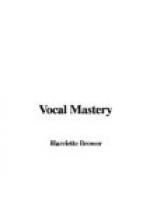“Painting is a great art,” he said; “an art which requires profound study. I have been a close student of this art for many years and love it more and more.”
“M. Maurel aims now to express himself through the art of color and form, as he has always done through voice and gesture,” remarked my friend.
“Art is the highest means of expression,” went on the master, “whether through music, painting, sculpture, architecture or the theater. The effort to express myself through another art-medium, painting, has long been a joy to me. I have studied with no teacher but myself, but I have learned from all the great masters; they have taught me everything.”
He then led the way to his music room on the floor above. Here were more paintings, many rare pieces of furniture and his piano. A fine portrait of Verdi, with an affectionate autograph, stood on a table; one of Ambroise Thomas, likewise inscribed, hung near. “A serious man, almost austere,” said Maurel, regarding the portrait of Verdi thoughtfully, “but one of the greatest masters of all time.”
Praying us to be seated, he placed himself on an ottoman before us. The talk easily drifted into the subject of the modern operatic stage, and modern operas of the Italian school, in which one is so often tempted to shout rather than sing. The hero of Mozart’s Don Giovanni, who could sing his music as perhaps no one else has ever done, would not be likely to have much patience with the modern style of explosive vocal utterance.
“How do you preserve your voice and your repertoire?” I questioned.
M. Maurel gazed before him thoughtfully.
“It is entirely through the mind that I keep both. I know so exactly how to produce tone qualities, that if I recall those sensations which accompany tone production, I can induce them at will. How do we make tones, sing an aria, impersonate a role? Is not all done with the mind, with thought? I must think the tone before I produce it—before I sing it; I must mentally visualize the character and determine how I will represent it, before I attempt it. I must identify myself with the character I am to portray before I can make it live. Does not then all come from thinking—from thought?
“Again: I can think out the character and make a mental picture of it for myself, but how shall I project it for others to see? I have to convince myself first that I am that character—I must identify myself with it; then I must convince those who hear me that I am really that character.” Maurel rose and moved to the center of the room.
“I am to represent some character—Amonasro, let us say. I must present the captive King, bound with chains and brought before his captors. I must feel with him, if I am really going to represent him. I must believe myself bound and a prisoner; then I must, through pose and action, through expression of face, gesture, voice, everything—I must make this character real to the audience.”




